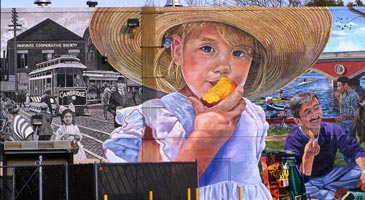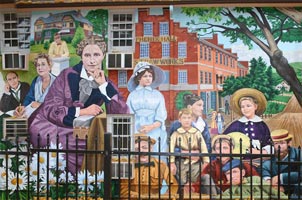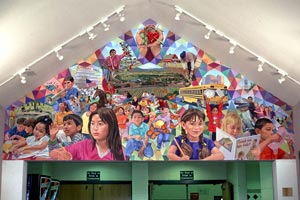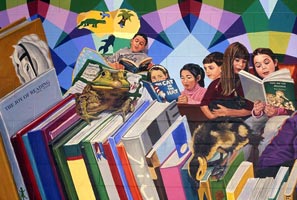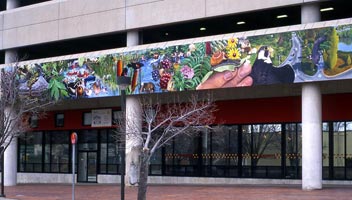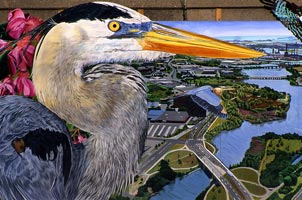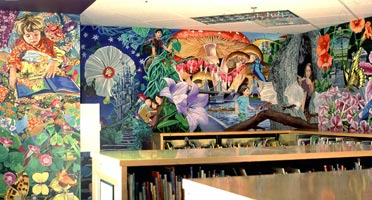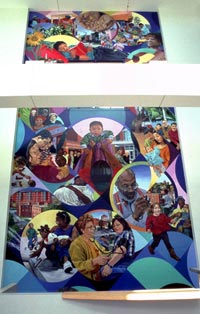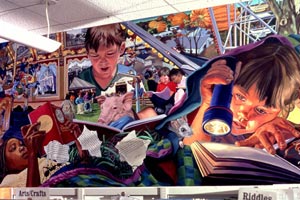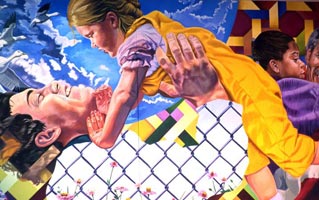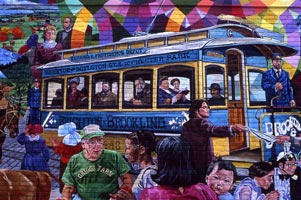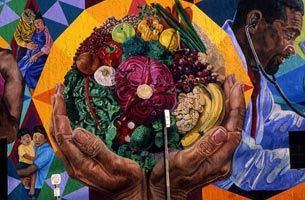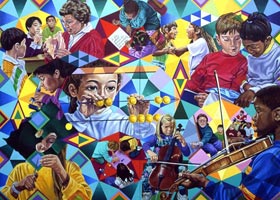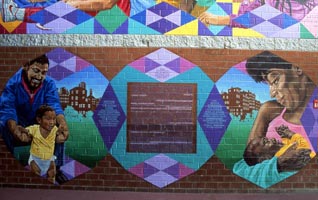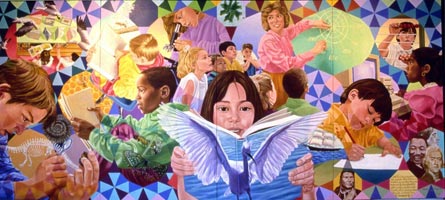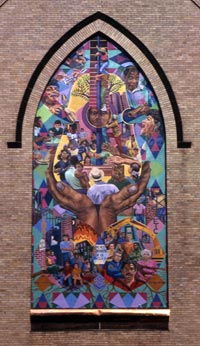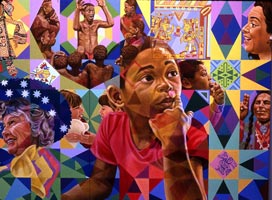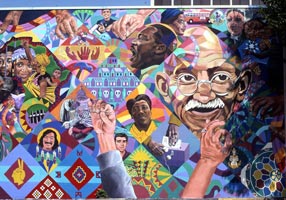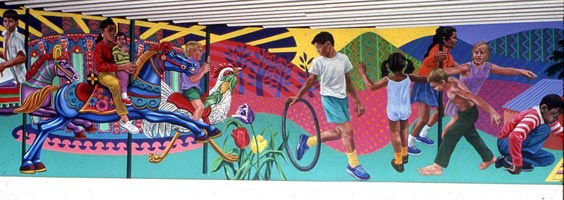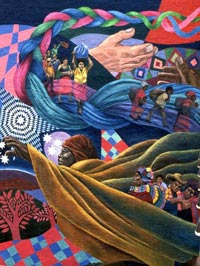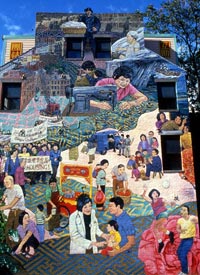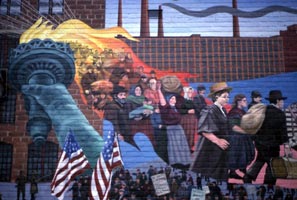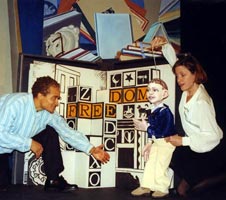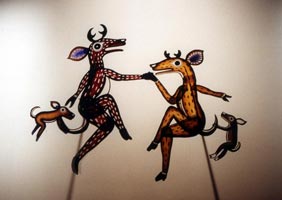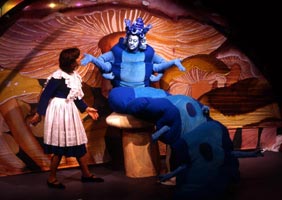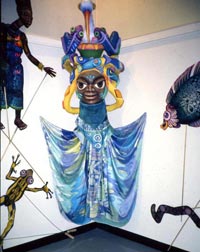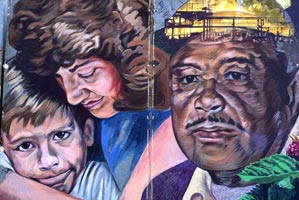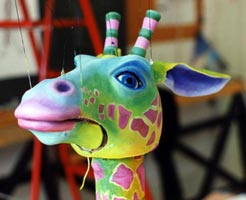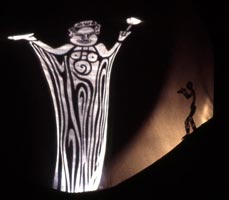 |
about RESUME links |
Resume
Education
1969 The Putney School Putney, VT
1973 Harvard College AB, Graduated Cum Laude
Commissioned Murals
2005 Sunday Afternoon on the Charles River Trader Joes, Cambridge MA
25’X120’ mural on the outside of a business in Cambridge, MA; it depicts people eating, playing, relaxing on the banks of the nearby Charles River. A section in black and white depicts a Cambridge landmark, Harvard Square, in the early 1900’s. Commissioned by Trader Joes.
25’X120’ mural on the outside of a business in Cambridge, MA; it depicts people eating, playing, relaxing on the banks of the nearby Charles River. A section in black and white depicts a Cambridge landmark, Harvard Square, in the early 1900’s. Commissioned by Trader Joes.
2005 Amherst Community History Mural
16’X145’ mural at West Cemetery (grave site of Emily Dickinson) in Amherst, MA; depicts the history of Amherst, with portraits of writers, farmers, educators, workers, and others buried in the cemetery. Sponsored by the Amherst Historical Commission.
16’X145’ mural at West Cemetery (grave site of Emily Dickinson) in Amherst, MA; depicts the history of Amherst, with portraits of writers, farmers, educators, workers, and others buried in the cemetery. Sponsored by the Amherst Historical Commission.
2003 Granger’s Bounty
7’X14’ mural at the entrance of Roosevelt Elementary School, in Granger, Washington. Mural depicts students in the school, migrant agricultural workers, landscape of the area, cultural traditions, and historical references. Commissioned by the Washington State Arts Commission
7’X14’ mural at the entrance of Roosevelt Elementary School, in Granger, Washington. Mural depicts students in the school, migrant agricultural workers, landscape of the area, cultural traditions, and historical references. Commissioned by the Washington State Arts Commission
2002 Joy of Reading
8’X35’ mural at the library of the Francis Wyman Elementary School, Burlington, MA. The mural depicts students reading in a landscape of books. The background is in a geometric pattern integrating student designs based on a favorite place to read (real or imaginary).
8’X35’ mural at the library of the Francis Wyman Elementary School, Burlington, MA. The mural depicts students reading in a landscape of books. The background is in a geometric pattern integrating student designs based on a favorite place to read (real or imaginary).
2004 The Alewife Reservation Mural Project
8’X80’ Alewife MBTA Station, Cambridge, MA. Mural depicts the ecology of the Alewife Reservation wetlands and was created with students from Cambridge Ringe and Latin High School.
8’X80’ Alewife MBTA Station, Cambridge, MA. Mural depicts the ecology of the Alewife Reservation wetlands and was created with students from Cambridge Ringe and Latin High School.
1996-2004 The Mystic River Journey
Mystic Ave., Somerville, MA. A nine year project working with teenagers from the Mystic Housing Project and science educators, combining science and art in the study and depiction of the ecology and history of an urban river. Sponsored by the Somerville Arts Council, the project received an award from
American Rivers Association in 1997. Mural panels are installed on Mystic Ave.
Mystic Ave., Somerville, MA. A nine year project working with teenagers from the Mystic Housing Project and science educators, combining science and art in the study and depiction of the ecology and history of an urban river. Sponsored by the Somerville Arts Council, the project received an award from
American Rivers Association in 1997. Mural panels are installed on Mystic Ave.
2001 The Story Garden Mural Billerica Public Library, Billerica, MA
A 5’X30’ mural depicting a magical story garden, with children reading.
A 5’X30’ mural depicting a magical story garden, with children reading.
2001 Community Caring, Community Healing The Martha Eliot Health Center, Jamaica Plain, MA
A 22’X12’ mural in the front lobby, depicting images of health care interwoven with community history and experiences.
A 22’X12’ mural in the front lobby, depicting images of health care interwoven with community history and experiences.
2000 Topsfield Reverie The Topsfield Public Library, Topsfield, MA
A 5’X35’ mural in the Childrens Room combining images of the town with those of children reading.
A 5’X35’ mural in the Childrens Room combining images of the town with those of children reading.
1996 Links Visiting room of the Racine Correctional Institution, Racine
This 7’X50’ mural on canvas, was commissioned by the Wisconsin Arts Board through a percent for art program. It depicts inmates, their families, and guards, while humanizing an institutional setting.
This 7’X50’ mural on canvas, was commissioned by the Wisconsin Arts Board through a percent for art program. It depicts inmates, their families, and guards, while humanizing an institutional setting.
1995 JFK Crossing Mural exterior wall, Brookline, MA
This 13’X45’ mural was sponsored by the Town of Brookline and depicts the history of the neighborhood where JFK grew up.
This 13’X45’ mural was sponsored by the Town of Brookline and depicts the history of the neighborhood where JFK grew up.
1994 The Potluck: Area 4 Community Mural exterior wall, Cambridge, MA
This 22’X100’ mural, sponsored by the Area 4 Neighborhood Coalition, is a portrait of a multi-ethnic neighborhood and incorporates design details drawn by youth. It was painted with assistance of paid youth and community volunteers.
This 22’X100’ mural, sponsored by the Area 4 Neighborhood Coalition, is a portrait of a multi-ethnic neighborhood and incorporates design details drawn by youth. It was painted with assistance of paid youth and community volunteers.
1993 Lifeline: Creating A Healthy Community exterior wall, Practicare Health Center, Los Angeles, CA
This 21’X145’ mural, sponsored by SPARC through their
Neighborhood Pride competition, combines images of healthcare and community. It was painted with the assistance of paid youth and community volunteers.
This 21’X145’ mural, sponsored by SPARC through their
Neighborhood Pride competition, combines images of healthcare and community. It was painted with the assistance of paid youth and community volunteers.
1992 Singing In the Dark Times exterior wall, Seven Stages Theater, Atlanta, GA
This 22’X145’ mural depicts theatrical images and portraits from different cultural traditions.
This 22’X145’ mural depicts theatrical images and portraits from different cultural traditions.
1992 The Kaleidoscope of Learning interior mural on canvas panels, Cresthaven Elem. School, S
This 6’X12’ mural depicts students in educational pursuits. It was sponsored by the Montgomery Co. Art in Public Schools program.
This 6’X12’ mural depicts students in educational pursuits. It was sponsored by the Montgomery Co. Art in Public Schools program.
1991 Children Are Our Future interior mural, Dimock Community Health Center, Roxbury, MA
This 30’X20’ mural in the Youth and Family Services Building contains portraits of youth and families from different ethnic backgrounds.
This 30’X20’ mural in the Youth and Family Services Building contains portraits of youth and families from different ethnic backgrounds.
1991 Dreams of Icarus interior murals on canvas panels, Ronald McNair Elem. School
This 7’X32’ mural (in two sections) has the central image of a child reading a book in the shape of a flying bird and celebrates the joy of learning.
This 7’X32’ mural (in two sections) has the central image of a child reading a book in the shape of a flying bird and celebrates the joy of learning.
1990 When All Knowledge Is Delight interior mural on canvas panels at the Cloverly
This mural is in two sections, 6’X30’ and 6’X12’. It depicts students in different kinds of learning situations in a celebratory manner. Sponsored by Montgomery Co. Art in Public Schools.
This mural is in two sections, 6’X30’ and 6’X12’. It depicts students in different kinds of learning situations in a celebratory manner. Sponsored by Montgomery Co. Art in Public Schools.
1990 Viva Villa Victoria exterior mural on the Jorge Hernandez Cultural Center, Bosto
This 13’X30’ mural on the outside of a cultural center, depicts the history of the struggle to preserve housing and community in the face of neighborhood changes.
This 13’X30’ mural on the outside of a cultural center, depicts the history of the struggle to preserve housing and community in the face of neighborhood changes.
1990 The Storyteller’s Quilt interior mural on stretched canvas panels, Rolling Terrace Elem. School, Tacoma Park, MD
This 8’X8’ mural weaves images of storytelling from different traditions and cultures in the pattern of a quilt.
This 8’X8’ mural weaves images of storytelling from different traditions and cultures in the pattern of a quilt.
1988 The Freedom Quilt Mural exterior mural on the American Friends Committee Building, Atlanta, GA
This 30’X60’ mural depicts a giant quilt being sewn by hands of of different races and ages, with the different quilt patches telling the story of the Civil Rights Movement, combining it with other examples of nonviolent social change.
This 30’X60’ mural depicts a giant quilt being sewn by hands of of different races and ages, with the different quilt patches telling the story of the Civil Rights Movement, combining it with other examples of nonviolent social change.
1988 Children Are the Future interior mural at the interior mural at the Silver Spring Center, Silver Spring, MD
This 3’X61’ was selected by competition by the Montgomery Co. Art in Public Architecture Program.
This 3’X61’ was selected by competition by the Montgomery Co. Art in Public Architecture Program.
1986 Sanctuary: The Spirit of Harriet Tubman exterior mural at the Paul Robeson Theater, Atlanta, GA
This 20’X15’ mural, sponsored by the City of Atlanta, depicts the abolitionist Tubman leading people to freedom on the Underground Railway.
This 20’X15’ mural, sponsored by the City of Atlanta, depicts the abolitionist Tubman leading people to freedom on the Underground Railway.
1986 Unity/Community:The Chinatown Mural Project exterior mural on Chinese community center, Boston, MA
This 40’X30’ mural was co-designed by Wen-ti Tsen painted with the assistance of community volunteers.
This 40’X30’ mural was co-designed by Wen-ti Tsen painted with the assistance of community volunteers.
1986 The Bread and Roses Mural exterior mural on the Greater Lawrence Family Health Center, Lawrence, MA
This 17’X50’ mural depicts the history of immigration to the historic mill town of Lawrence and a famous early 20th century mill strike.
This 17’X50’ mural depicts the history of immigration to the historic mill town of Lawrence and a famous early 20th century mill strike.
Student Murals
title
description
description
Theatre Design
2001 How Do You Spell Hope
original play for families based on three struggles with reading. Set design based on “pop up” books, with rod marionettes, shadow puppets, and others. This touring production by the Underground Railway Theater recently completed an engagement at the Kennedy Center in Washington DC.
original play for families based on three struggles with reading. Set design based on “pop up” books, with rod marionettes, shadow puppets, and others. This touring production by the Underground Railway Theater recently completed an engagement at the Kennedy Center in Washington DC.
2001 The Tempest
a shadow puppet adaptation of Shakespeare’s play, commissioned and performed by the Boston Symphony Orchestra, with the Underground Railway Theater. Designed and painted shadow and reflective puppets, as well as silk set backdrops.
a shadow puppet adaptation of Shakespeare’s play, commissioned and performed by the Boston Symphony Orchestra, with the Underground Railway Theater. Designed and painted shadow and reflective puppets, as well as silk set backdrops.
1998 Alice Underground
an adaptation of “Alice in Wonderland” and “Through the Looking Glass” by URT. Designed sets (painted silk drops), puppets, and masks. Received citation for Best Theater Design 1998 from Boston Outer Circle Critics.
an adaptation of “Alice in Wonderland” and “Through the Looking Glass” by URT. Designed sets (painted silk drops), puppets, and masks. Received citation for Best Theater Design 1998 from Boston Outer Circle Critics.
1994 Creation of the World
a shadow puppet play based on Yoruba creation stories with music by Darius Milhaud. Designed shadow screen set, with carved wooden border based on Yoruba divination trays. Designed and painted shadow puppets, masks and costumes for URT. Premier at Lincoln Center, NYC, with subsequent performances with Chicago and Boston Symphony Orchestras.
a shadow puppet play based on Yoruba creation stories with music by Darius Milhaud. Designed shadow screen set, with carved wooden border based on Yoruba divination trays. Designed and painted shadow puppets, masks and costumes for URT. Premier at Lincoln Center, NYC, with subsequent performances with Chicago and Boston Symphony Orchestras.
1993 Intoxicating: An Eco-Caberet
set design and painting. Original play by the Underground Railway Theater.
set design and painting. Original play by the Underground Railway Theater.
1992 La Bain de Noe (Noah’s Bath)
by Marionettes de Geneve (Geneva, Switzerland) and directed by Eric Bass; designed and painted sets and marionettes.
by Marionettes de Geneve (Geneva, Switzerland) and directed by Eric Bass; designed and painted sets and marionettes.
1992 The Christopher Columbus Follies
by the Underground Railway Theater; designed sets, puppets, and masks.
by the Underground Railway Theater; designed sets, puppets, and masks.
1989 Museum of Science Gold Exhibition Play
designed rod puppet and giant gold mountain puppet.
designed rod puppet and giant gold mountain puppet.
Published Work
Walls of Heritage/Walls of Pride James Prigoff and Robin Dunitz (mural featured)
Murals: Walls that Sing George Ancona (reproductions of three murals featured)
Art On The Walls : Murals in New England Robin Dunitz
Reviews of Life of Galileo Review for Life of Galileo
The Life of Galileo
by Kilian?Melloy
EDGE Contributor
Saturday Apr 11, 2009
?The Life of Galileo? plays through May 17. ?? (Source:Central Square Theater)
It?s depressing to read in the program notes for The Central Square Theatre?s production of Bertolt Brecht?s The Life of Galileo that as recently as 1994, a third of the respondents to a survey in Britain thought that the sun revolves around the Earth. The plays staged at the still-young theater have tended to have a scientific bent, celebrating the life of Richard Feynman and the dreams of Albert Einstein, dipping into the fantastical realm of mathematician Lewis Carroll?s fantasies, and now peering closely at one of the most startling, even troubling, and yet liberating discoveries in history: the fact that we (humankind) who live here (on the Earth) are not, appearances to the contrary, the center of creation. But it seems that four centuries after Galileo had a look through a telescope and discerned something about the true nature of the cosmos, there are a great number of people out there who still haven?t heard the news. Scientific illiteracy on a shockingly fundamental level is still very much with us in the 21st century, and that, too, is a subject fit for dramatic interpretation. The program notes also tell us that Bertolt Brecht wrote "The Life of Galileo" in 1938, during a three-week burst of creativity propelled by anger at the way scientists were co-opted by the Nazis. He had every right to be angry: science is the single most powerful and pure instrument available to us as we seek those fundamental things that so many other social movements claim to cherish: truth, for one, and the betterment of human life. And yet science is often looked down on, dismissed--or, worse, used selectively in order gratify the basest of human instincts, its loftier goals and possibilities all too often discarded. The play tells us that Gallileo?s clash with the hierarchy of the Catholic church had less to do reason and superstition running afoul of one another than the freedom promised by rational inquiry challenging the doctrinal authority of the church. There?s a rationale even behind the church?s reluctance to accept what is, literally, right before their eyes--if only they?d have a look through the telescope and see if for themselves: in one emotionally wrenching scene, a contingent of nobility and church officials ignore the telescope and enter into a self-reenforcing verbal game based on nothing more than the writings of Artistotle and the Bible: the evidence of their own eyes counts for less than the received wisdom of the time. But behind these verbal jousting matches lies a true terror of seeing people come unmoored should their conception of the world be turned upside down. Brecht?s play depicts a struggle, not so much between science and religion, but between two different kinds of faith. At several junctures, but in particular during one lengthy, passionate argument with a monk who is also a physicist, Galileo (played with magnificent brio by Richard McElvain) argues that common people themselves are the engine of true human progress: the laborers and sailors that the nobility look down upon are the true innovators, and if given the means of understanding the true nature of the universe, they will incorporate that understanding with relative ease into their daily lives. But religious faith, the counter-argument runs, is all that gives most people a reason to keep living and working. Without a sense of centrality to God?s plan, common folk would find life too hard, too humiliating, too unjust. The church officials may or may not truly have faith in God, but they do have faith in the social order that the church imposes, sometimes through torture and execution. Like the belief that the sun orbits the earth, those ideas persist today, and Brecht?s dialogue--as translated by David Hare--rings time and again with the very same arguments still made by those who oppose science. Brecht gives those arguments their due, showing how Galileo--a creature of earthly pleasures for all that his mind is directed out into the heavens--is willing to disrupt the lives of those around him for the sake of his work, even derailing the marriage of his daughter Virginia (Amanda Collins) to Ludovico (Kevin Kaine). But all it takes are a few weeks in prison and a glimpse of the torture devices the church uses to maintain its hold over social order, and Galileo publicly renounces his own theories--which is to say, the evidence seen by his own eyes. The hope that Brecht builds into the play is personified by Andrea, a student (or disciple) of Galileo since boyhood. As a child (Andrew Cekala), Andrea quickly grasps and internalizes the facts that Galileo teaches him and the mental framework that allows him to arrange those facts into a world-view. Andrea grows up to become a scientist himself, though he also inherits Galileo?s arrogance and impatience. As a man (Lewis D. Wheeler), Andrea is shattered by Galileo?s recantation: he would rather have seen his mentor suffer and die as a martyr to science, because he believes that such a sacrifice would have prompted an intellectual revolution in which doctrine of all kinds would have been cast aside and free inquiry demanded by the commoners. "Truth will conquer only if we do," he cries. It?s an interesting hypothesis, but Galileo himself warns against the doctrine to which science itself also can be vulnerable. The church fears that "Unrestricted research is a danger to humanity"--a refrain we hear today, and a concern that is not without its instructive applications. But Galileo returns, again and again, to a simple (and perpetually overlooked) point: science, and its fruits, must serve human freedom and human needs. By itself, science has no innate moral compass: a rumble (courtesy of Ramon Castillo?s sound design) underscores Galileo?s palpable dread of horrors to come, should science become a new sort of blindly inflexible dogma. We, however, recognize it for what Brecht probably intended to imply: the sound of a nuclear explosion. The program notes describe "The Life of Galileo" a "monumental," and the Central Square Theater has treated the play?s production accordingly: the set (by David Fichter) offers simple, yet expressive, design elements, extending out into the audience, with an elaborate pattern on the floor and a platform and catwalk providing successive levels upon which the actors stand (and surely it?s no accident that Galileo exalts loftily in his new discoveries from the highest perch). Just as well-assembled is the cast, which includes Stephen Barkhimer, Jason Bowen, Robert Najarian, James Patrick Nelson, Stephen Russell, Vincent Ernest Siders, Tim Traversi, and Debra Wise; most of the cast take on multiple roles, but director David Wheeler guides them into a well-integrated ensemble. A handsomely costumed ensemble, at that: Heidi Hermiller dresses the cast in variety of materials, from leather jerseys and simple linens to royally red surplices and layered dresses, aprons, and bonnets. The occasional sartorial anachronism winks out at us: a modern T-shirt, for example; and there are times when the costume changes that allow actors to shift from one role to another are deliberately incomplete: it?s a striking effect. Kenneth Helvig?s lighting design also enjoys an extra layer, thanks to a cloth screen at the back of the set where super-titles announce the place and year (the play spans more than three decades and is set in a number of cities). The backdrop takes on a blue glow by night, and projected spots of light depict the stars; that same backdrop takes on an infernal red glow, all too reminiscent of the human bonfires the church made out of "heretics," or else it hosts shadows that sketch out the settings more fully: figures step through court dances, or shuffle along in procession as though going to communion during mass. We?re reminded, though not in any intrusive way, that Galileo?s discoveries, and his attempts to defend them, take place in a certain time and atmosphere: a stringent, tightly controlled time when new ideas were seen, as one character puts it, as "frivolous attacks" against the church-dominated social and political order. The set is flanked by two massive murals that cover the walls of the auditorium: our solar system is depicted, and drifting among the planets are objects that summarize our history and ambitions: statues of military leaders, fragments of Doric columns, towers and university buildings... and a sports car. The implication is that we can reach for stars, or we can become one more bit of dashed and drifting detritus. "The Life of Galileo plays at The Central Square Theater, located at 450 Massachusetts Avenue in Cambridge, through May 17. Performance schedule: Wednesdays and Thursdays: 7:30 p.m. Fridays and Saturdays: 8:00 p.m. Sundays: 3:00 p.m. Tickets cost $32 general admission, $22 for senior citizens, $18 for students (valid ID required). Day-of student rush tickets are also available for $12. Tickets can be purchased online. Pre-performance symposia and post-performance talk-backs are also scheduled; full details can be found at the Central Square Theater Web site. Kilian Melloy reviews media, conducts interviews, and writes commentary for EDGEBoston, where he also serves as Assistant Arts Editor.
?The Life of Galileo? plays through May 17. ?? (Source:Central Square Theater)
It?s depressing to read in the program notes for The Central Square Theatre?s production of Bertolt Brecht?s The Life of Galileo that as recently as 1994, a third of the respondents to a survey in Britain thought that the sun revolves around the Earth. The plays staged at the still-young theater have tended to have a scientific bent, celebrating the life of Richard Feynman and the dreams of Albert Einstein, dipping into the fantastical realm of mathematician Lewis Carroll?s fantasies, and now peering closely at one of the most startling, even troubling, and yet liberating discoveries in history: the fact that we (humankind) who live here (on the Earth) are not, appearances to the contrary, the center of creation. But it seems that four centuries after Galileo had a look through a telescope and discerned something about the true nature of the cosmos, there are a great number of people out there who still haven?t heard the news. Scientific illiteracy on a shockingly fundamental level is still very much with us in the 21st century, and that, too, is a subject fit for dramatic interpretation. The program notes also tell us that Bertolt Brecht wrote "The Life of Galileo" in 1938, during a three-week burst of creativity propelled by anger at the way scientists were co-opted by the Nazis. He had every right to be angry: science is the single most powerful and pure instrument available to us as we seek those fundamental things that so many other social movements claim to cherish: truth, for one, and the betterment of human life. And yet science is often looked down on, dismissed--or, worse, used selectively in order gratify the basest of human instincts, its loftier goals and possibilities all too often discarded. The play tells us that Gallileo?s clash with the hierarchy of the Catholic church had less to do reason and superstition running afoul of one another than the freedom promised by rational inquiry challenging the doctrinal authority of the church. There?s a rationale even behind the church?s reluctance to accept what is, literally, right before their eyes--if only they?d have a look through the telescope and see if for themselves: in one emotionally wrenching scene, a contingent of nobility and church officials ignore the telescope and enter into a self-reenforcing verbal game based on nothing more than the writings of Artistotle and the Bible: the evidence of their own eyes counts for less than the received wisdom of the time. But behind these verbal jousting matches lies a true terror of seeing people come unmoored should their conception of the world be turned upside down. Brecht?s play depicts a struggle, not so much between science and religion, but between two different kinds of faith. At several junctures, but in particular during one lengthy, passionate argument with a monk who is also a physicist, Galileo (played with magnificent brio by Richard McElvain) argues that common people themselves are the engine of true human progress: the laborers and sailors that the nobility look down upon are the true innovators, and if given the means of understanding the true nature of the universe, they will incorporate that understanding with relative ease into their daily lives. But religious faith, the counter-argument runs, is all that gives most people a reason to keep living and working. Without a sense of centrality to God?s plan, common folk would find life too hard, too humiliating, too unjust. The church officials may or may not truly have faith in God, but they do have faith in the social order that the church imposes, sometimes through torture and execution. Like the belief that the sun orbits the earth, those ideas persist today, and Brecht?s dialogue--as translated by David Hare--rings time and again with the very same arguments still made by those who oppose science. Brecht gives those arguments their due, showing how Galileo--a creature of earthly pleasures for all that his mind is directed out into the heavens--is willing to disrupt the lives of those around him for the sake of his work, even derailing the marriage of his daughter Virginia (Amanda Collins) to Ludovico (Kevin Kaine). But all it takes are a few weeks in prison and a glimpse of the torture devices the church uses to maintain its hold over social order, and Galileo publicly renounces his own theories--which is to say, the evidence seen by his own eyes. The hope that Brecht builds into the play is personified by Andrea, a student (or disciple) of Galileo since boyhood. As a child (Andrew Cekala), Andrea quickly grasps and internalizes the facts that Galileo teaches him and the mental framework that allows him to arrange those facts into a world-view. Andrea grows up to become a scientist himself, though he also inherits Galileo?s arrogance and impatience. As a man (Lewis D. Wheeler), Andrea is shattered by Galileo?s recantation: he would rather have seen his mentor suffer and die as a martyr to science, because he believes that such a sacrifice would have prompted an intellectual revolution in which doctrine of all kinds would have been cast aside and free inquiry demanded by the commoners. "Truth will conquer only if we do," he cries. It?s an interesting hypothesis, but Galileo himself warns against the doctrine to which science itself also can be vulnerable. The church fears that "Unrestricted research is a danger to humanity"--a refrain we hear today, and a concern that is not without its instructive applications. But Galileo returns, again and again, to a simple (and perpetually overlooked) point: science, and its fruits, must serve human freedom and human needs. By itself, science has no innate moral compass: a rumble (courtesy of Ramon Castillo?s sound design) underscores Galileo?s palpable dread of horrors to come, should science become a new sort of blindly inflexible dogma. We, however, recognize it for what Brecht probably intended to imply: the sound of a nuclear explosion. The program notes describe "The Life of Galileo" a "monumental," and the Central Square Theater has treated the play?s production accordingly: the set (by David Fichter) offers simple, yet expressive, design elements, extending out into the audience, with an elaborate pattern on the floor and a platform and catwalk providing successive levels upon which the actors stand (and surely it?s no accident that Galileo exalts loftily in his new discoveries from the highest perch). Just as well-assembled is the cast, which includes Stephen Barkhimer, Jason Bowen, Robert Najarian, James Patrick Nelson, Stephen Russell, Vincent Ernest Siders, Tim Traversi, and Debra Wise; most of the cast take on multiple roles, but director David Wheeler guides them into a well-integrated ensemble. A handsomely costumed ensemble, at that: Heidi Hermiller dresses the cast in variety of materials, from leather jerseys and simple linens to royally red surplices and layered dresses, aprons, and bonnets. The occasional sartorial anachronism winks out at us: a modern T-shirt, for example; and there are times when the costume changes that allow actors to shift from one role to another are deliberately incomplete: it?s a striking effect. Kenneth Helvig?s lighting design also enjoys an extra layer, thanks to a cloth screen at the back of the set where super-titles announce the place and year (the play spans more than three decades and is set in a number of cities). The backdrop takes on a blue glow by night, and projected spots of light depict the stars; that same backdrop takes on an infernal red glow, all too reminiscent of the human bonfires the church made out of "heretics," or else it hosts shadows that sketch out the settings more fully: figures step through court dances, or shuffle along in procession as though going to communion during mass. We?re reminded, though not in any intrusive way, that Galileo?s discoveries, and his attempts to defend them, take place in a certain time and atmosphere: a stringent, tightly controlled time when new ideas were seen, as one character puts it, as "frivolous attacks" against the church-dominated social and political order. The set is flanked by two massive murals that cover the walls of the auditorium: our solar system is depicted, and drifting among the planets are objects that summarize our history and ambitions: statues of military leaders, fragments of Doric columns, towers and university buildings... and a sports car. The implication is that we can reach for stars, or we can become one more bit of dashed and drifting detritus. "The Life of Galileo plays at The Central Square Theater, located at 450 Massachusetts Avenue in Cambridge, through May 17. Performance schedule: Wednesdays and Thursdays: 7:30 p.m. Fridays and Saturdays: 8:00 p.m. Sundays: 3:00 p.m. Tickets cost $32 general admission, $22 for senior citizens, $18 for students (valid ID required). Day-of student rush tickets are also available for $12. Tickets can be purchased online. Pre-performance symposia and post-performance talk-backs are also scheduled; full details can be found at the Central Square Theater Web site. Kilian Melloy reviews media, conducts interviews, and writes commentary for EDGEBoston, where he also serves as Assistant Arts Editor.
Awards
1997 American Rivers Association Award for Mystic River Mural Project
Exhibits [mural related]
2001 "Public Murals of the Boston Area"; Boston Public Library [numerous murals featured]
1994 “Public Interventions” at the Institute of Contemporary Art, Boston, MA. An installation about the Chinatown Community Mural.
1990 “Operation Family Values” at the Fuller Museum of Art, Brockton, MA. A temporary mural installation on a museum wall.
